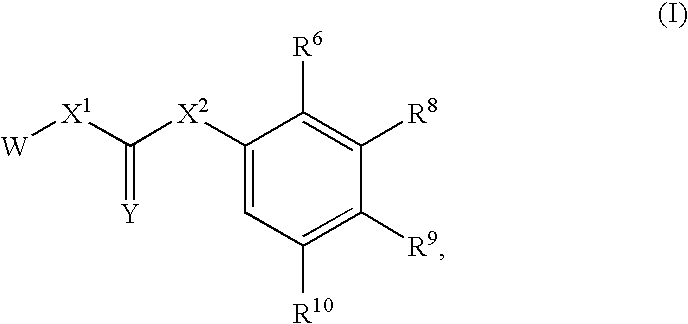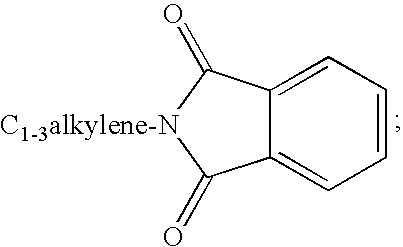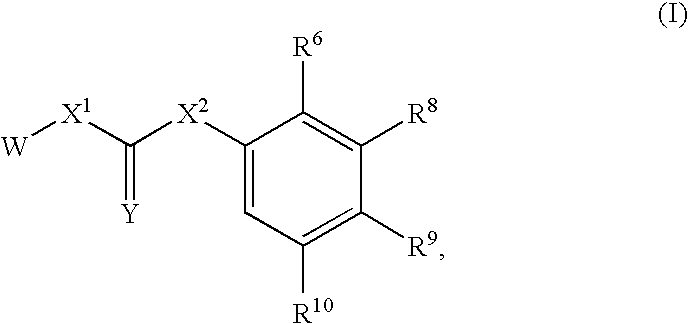Compounds Useful for Inhibiting Chk1
a technology of compounds and compounds, applied in the field of compounds, can solve the problems of affecting the treatment of aberrant cell proliferation conditions, the effectiveness of dna damaging agents in treating conditions involving aberrant cell proliferation is less than desired, and undermines efforts to induce dna damage, etc., to achieve the effect of inhibiting or preventing aberrant cell proliferation
- Summary
- Abstract
- Description
- Claims
- Application Information
AI Technical Summary
Benefits of technology
Problems solved by technology
Method used
Image
Examples
example 1
Determination of IC50 Values of the Chk1 Inhibitors
[0169]Human Chk1 cDNA was identified and cloned as described previously in International Application Publication No. WO 99 / 11795, filed Sep. 4, 1998. A FLAG tag was inserted in frame with the amino terminus of the full-length Chk1. The 5′ primer contains an EcoRI site, a Kozak sequence, and also encodes a FLAG® tag for affinity purification using the M2 Antibody (Sigma, Saint Louis, Ill.). The 3′ primer contains a SalI site. The PCR-amplified fragment was cloned into pCI-Neo as an EcoRI-SalI fragment (Invitrogen, Carlsbad, Calif.), then subcloned as an EcoRI-NotI fragment into pFastBacI (Gibco-BRL, Bethesda, Md.). Recombinant baculovirus was prepared as described in the Gibco-BRL Bac-to-Bac manual and used to infect Sf-9 cells grown in CCM3 medium (HyClone Laboratories, Logan, Utah) for expression of FLAG®-tagged Chk1 protein.
[0170]FLAG®-tagged Chk1 was purified from frozen pellets of baculovirus-infected SF9 cells. Frozen cell pell...
example 2
Selectivity
[0172]Chk1 inhibitors of the present invention were tested for selectivity as against one or more other protein kinases, i.e., DNA-PK, Cdc2, Casein Kinase I (CKI), Chk2, p38 MAP kinase, ERK kinase, Protein Kinase A (PKA), and / or calcium-calmodulin protein kinase II (CaM KII).
[0173]Assay procedures for all of these kinases except Chk2 have been previously described in the literature, including U.S. Patent Publication No. 2002-016521 A1, and U.S. patent application Ser. No. 08 / 184,605, filed Jan. 21, 1994, both of which are herein incorporated by reference.
[0174]Activity of the compounds against Chk2 was assayed as follows: 128 ng of purified His-tagged Chk2 was incubated with up to 100 mM Chk1 inhibitor in the presence of 4 mM ATP, 1 mCi [32P]γ-ATP, 20 mM Hepes pH 7.5, 5 mM MgCl2, and 0.25% NP40 for 20 minutes at room temperature. Reactions were stopped with a final concentration of 150 mM phosphoric acid, and ⅝ of the reaction mixture was transferred to phosphocellulose d...
example 3
Chk1 Inhibitors of the Invention Inhibit Chk1 Function in Cells
[0176]To establish that the Chk1 inhibitors of the invention inhibit Chk1 function in-cells, inhibitors can be tested in molecular cell-based assays. Because mammalian Chk1 has been shown to phosphorylate Cdc25C in vitro, suggesting that it negatively regulates cyclin B / cdc2 in response to DNA damage, the ability of the Chk1 inhibitors to enhance the activity of CyclinB / cdc2 can be analyzed. The experiment can be designed as follows: HeLa cells are irradiated with 800 rads and incubated for 7 hours at 37° C. Because these cells are functionally p53 negative, they arrest exclusively in G2. Then, nocodazole is added to a concentration of 0.5 μg / mL and the cells are incubated for 15 hours at 37° C. The addition of nocodazole is designed to trap any cells that progress through the G2 arrest into M. Finally, a Chk1 inhibitor is added for 8 hours, the cells harvested, lysed and immunoprecipitated equal amounts of protein with ...
PUM
 Login to View More
Login to View More Abstract
Description
Claims
Application Information
 Login to View More
Login to View More - Generate Ideas
- Intellectual Property
- Life Sciences
- Materials
- Tech Scout
- Unparalleled Data Quality
- Higher Quality Content
- 60% Fewer Hallucinations
Browse by: Latest US Patents, China's latest patents, Technical Efficacy Thesaurus, Application Domain, Technology Topic, Popular Technical Reports.
© 2025 PatSnap. All rights reserved.Legal|Privacy policy|Modern Slavery Act Transparency Statement|Sitemap|About US| Contact US: help@patsnap.com



